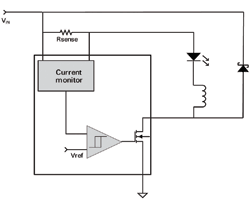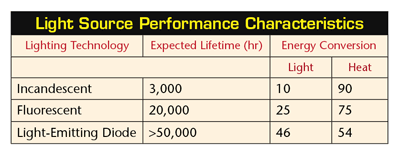LEDs’ advantages/challenges for municipal lighting
The local-government programs are focusing on the costs of lighting, which can account for 20% of the energy budgetfor most local governments, energy savings is currently a key strategic goal, encompassing new initiatives in electricity… http://www.nxtbook.com/nxtbooks/hearst/projectlighting_200810/index.php?startid=5

LED-driving apps using hysteretic converters
To fully exploit the hysteretic converter’s features, close attention must be paid to thermal management and EMC considerations… http://www.nxtbook.com/nxtbooks/hearst/projectlighting_200810/index.php?startid=9

Fig. 1. A hysteretic converter, in a basic step-down configuration, is an important section of an LED lighting system.
Selecting LEDs for gaming applications
Energy efficiency, functionality, reliability and cost to create a compelling case for changing to solid-state lighting… http://www.nxtbook.com/nxtbooks/hearst/projectlighting_200810/index.php?startid=14

Viewpoint
It’s a done deal
The other day I received a demo kit from Cree consisting of two quad-LED devices—one warm white and one cool white, mounted on separate boards with driver electronics—and two ordinary 9-V batteries to power up each of the boards. When I flicked the switch to turn the cool white version on, I made the mistake of looking directly at the LED; it was like being blinded by a flash bulb, complete with retinal afterimage. It happened to be a stormy day, and one co-worker remarked he thought there had been a nearby lighting strike.
A few days after, OSRAM announced its development engineers had achieved new records for the brightness and efficiency of white LED s in the laboratory. Under standard conditions with an operating current of 350 mA. Brightness peaked at a value of 155 lm and efficiency at 136 lm/W using prototype 1-mm2 LED chips.
This announcement came about a month after the OLLA project, a joint basic Organic LED research consortium, headed by Philips Lighting, presented its final milestone: the basic technology for a white OLED light source, with an efficacy of 50.7 lm/W at an initial brightness of 1,000 cd/m². The source was based on Novaled PIN OLED technology.
And then I watched the LED-saturated opening of the 2008 Olympics in Beijing.
These recent events have made it blindingly clear that the future of lighting is clearly solid state. As this and other Project Lighting series issues demonstrate, the technology for making efficient and practical lighting is no longer just a laboratory curiosity; it is coming out of the labs and into the marketplace. And that is becoming clear to incandescent manufacturers as well, who are undertaking projects to significantly increase the efficiency of their products.
But it’s too late for the old light bulb. Solid-state lighting is proving its viability and beginning to show its strength. For all practical purposes, LED lighting is a done deal.
Richard Comerford
rcomerford@hearst.com
For more on Project Lighting, visit www.electronicproducts.com/projectlighting!
Advertisement
Learn more about Electronic Products Magazine





